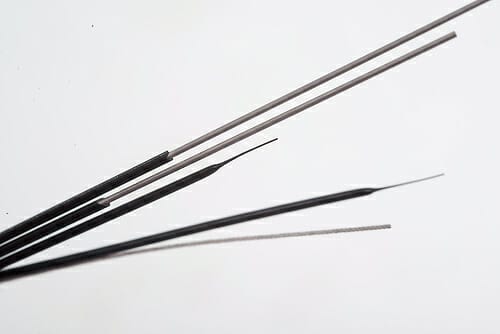
What is medical plastic wire coating extrusion?
Putnam Plastics can extrude thermoplastic materials over wire or incorporate the wire into the wall of an extrusion allowing the lumen to remain open. Putnam can also apply fluoropolymers, bioresorbables, and thermoset polyimide through a variety of processes. We offer all of these in discrete or continuous lengths. We are able to provide coatings down to 0.0001” (0.00254 mm).
What materials are used in wire coatings?
- Metal wires and polymer fibers can be coated with a wide range of thermoplastic and thermoset polyimide materials. Although, the most commonly jacketed wire is stainless steel, Putnam has the technology to coat copper, silver plated copper, nitinol, precious metals, as well as a range of polymer based fibers, such as kevlar and vectran.
- Wire coating material such as medical grade thermoplastic polymers, fluoropolymers, bioresorbables, thermoset polyimide and others are chosen based on your device requirements.
- Continuous jacketing of thermoset polyimide lumen linings, wires, fiber optics, aramid fiber reinforcement, and more are available.
- Discrete jacketing of tapered guide wires (including pre-cut Nitinol or stainless steel), laser cut and/or tapered hypotubes, and micro-coils are also offered.
What options should you keep in mind when procuring medical wire coating?
Medical plastic sleevings fulfill a variety of medical application needs:
- Radiopaque coatings can be seen in x-rays of the body, useful in both diagnostic and treatment procedures.
- Bioresorbables on the wire can resorb over time in the body so the mass is reduced.
- Some coatings are applied for lubricity purposes, others enhance steerability, such as wire-in-wall types, or improve conductivity such as coating of copper bundles.
- Putnam can also coat optical fibers.
What other Putnam technologies can be used with a wire coating?
Putnam Plastics can jacket discrete length wires, as well as provide intermittent jacketing of a wire. The discrete length wires can be tapered or have a constant OD. Putnam can also jacket wires by encapsulating them in a wall of a single or multi-lumen tube.
Why would you choose this type of technology over others?
- Putnam Plastics’ jacketing process is continuous and therefore more cost effective than dipping, or applied in a lay up process.
- With Putnam Plastics’ ability to jacket metal wires by incorporating them in the wall of a single or multi-lumen extrusion, engineers have numerous design options.
- The polymer jacketing of an annealed wire allows the part to be manually formed and hold its shape.
- The incorporation of a longitudinal polymer fiber of metal wire in the wall of an extrusion can eliminate the elongation of the part.
What medical devices, body parts, or procedures is this commonly used in?
- Putnam offers custom wire coating for a wide range of performance applications that require medical plastic sleeving— from fluoropolymer coating of electrical wires to thermoplastic elastomer coating of medical catheter guide wires.
- Our precision manufacturing has produced guidewires used in endovascular treatments such as endovascular coiling for brain aneurysms require a lubriciousness coating to move smoothly through the blood vessels.
What ISO certifications is Putnam equipped to comply with?
Putnam Plastics is ISO 13485:2016 certified.

Why is Putnam the best choice for wire-coating applications?
Customers count on Putnam for:
- proven quality controls
- our ability to customize tubing to specifications, and
- our flexibility to work within parameters while merging the best practices to give you the most cost-competitive result.
To speak with a Putnam engineer or sales representative about your medical tubing needs, click below. Over four decades of experience and some of the best engineering minds in the plastics business ensure excellence and dependability.
